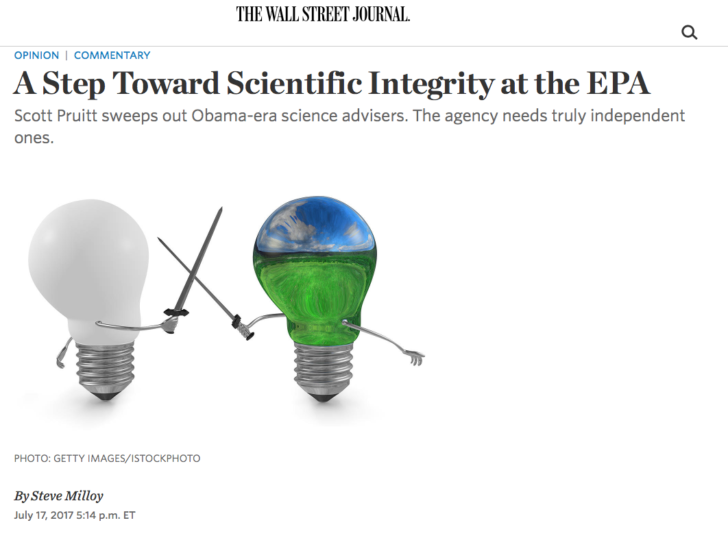By Steve Milloy
The Trump administration in May began the process of replacing the
small army of outside science advisers at the Environmental Protection
Agency. In June, 38 additional EPA advisers were notified that their
appointments would not be renewed in August. To Mr. Trump’s critics,
this is another manifestation of his administration’s “war on science.”
Histrionics aside, the administration’s actions are long overdue.
The most prominent of the EPA’s myriad boards of outside advisers are
the Science Advisory Board and the Clean Air Scientific Advisory
Committee, or CASAC. Mostly made up of university professors, these
boards also frequently draw members from consulting firms and activist
groups. Only rarely do members have backgrounds in industry. All EPA
boards are governed by the Federal Advisory Committee Act, which
requires that they be balanced and unbiased. While the EPA is required
by law to convene the SAB and CASAC, the agency is not bound by law to
heed their advice.
The EPA’s Obama -era “war on coal” rules and its standards for
ground-level ozone—possibly the most expensive EPA rule ever
issued—depend on the same scientifically unsupported notion that the
fine particles of soot emitted by smokestacks and tailpipes are lethal.
The EPA claims that such particles kill hundreds of thousands of
Americans annually.
The EPA first considered regulating fine particles in the mid-1990s.
But when the agency ran its claims past CASAC in 1996, the board
concluded that the scientific evidence did not support the agency’s
regulatory conclusion. Ignoring the panel’s advice, the EPA’s leadership
chose to regulate fine particles anyway, and resolved to figure out a
way to avoid future troublesome opposition from CASAC.
In 1996 two-thirds of the CASAC panel had no financial connection to
the EPA. By the mid-2000s, the agency had entirely flipped the
composition of the advisory board so two-thirds of its members were
agency grantees. Lo and behold, CASAC suddenly agreed with the EPA’s
leadership that fine particulates in outdoor air kill. During the Obama
years, the EPA packed the CASAC panel. Twenty-four of its 26 members are
now agency grantees, with some listed as principal investigators on EPA
research grants worth more than $220 million.
Although the scientific case against particulate matter hasn’t
improved since the 1990s, the EPA has tightened its grip on CASAC. In
effect, EPA-funded researchers are empowered to review and approve their
own work in order to rubber-stamp the EPA’s regulatory agenda. This is
all done under the guise of “independence.”
Another “independent” CASAC committee conducted the most recent
review of the Obama EPA’s ground-level ozone standards. Of that panel’s
20 members, 70% were EPA grantees who’d hauled in more than $192 million
from the agency over the years. These EPA panels make decisions by
consensus, which has lately been easy enough to achieve considering they
are usually chaired by an EPA grantee.
Would-be reformers have so far had no luck changing the culture at
these EPA advisory committees. In 2016 the Energy and Environment Legal
Institute, where I am a senior fellow, sued the agency. We alleged that
the CASAC fine-particulate subcommittee was biased—a clear violation of
the Federal Advisory Committee Act. We found a plaintiff who had been
refused CASAC membership because of his beliefs about fine particles.
Unfortunately, that individual was not willing to take a hostile public
stand against the EPA for fear of professional retribution. We
ultimately withdrew the suit.
The EPA’s opaque selection process for membership on its advisory
boards has opened the agency to charges of bias. In 2016 Michael
Honeycutt, chief toxicologist of the Texas Commission on Environmental
Quality, was recommended in 60 of the 83 nominations to the EPA for
CASAC membership. The EPA instead selected Donna Kenski of the Lake
Michigan Air Directors Consortium. Ms. Kenski received only one of the
83 recommendations. While no one objected to Mr. Honeycutt’s nomination,
Sen. James Inhofe (R., Okla.) lodged an objection to Ms. Kenski’s
nomination, claiming she had exhibited partisanship during an earlier
term on the committee.
Congress has also tried to reform the EPA’s science advisory process.
During the three most recent Congresses, the House has passed bills to
provide explicit conflict-of-interest rules for EPA science advisers,
including bans on receiving EPA grants for three years before and after
service on an advisory panel. The bills went nowhere in the Senate,
where the threat of a Democrat-led filibuster loomed. Had they passed,
President Obama surely would have vetoed them.
President Trump and his EPA administrator have ample statutory
authority to rectify the problem. As Oklahoma’s attorney general, Scott
Pruitt spent years familiarizing himself with the EPA’s unlawful ways.
He is in the process of reaffirming the independence of the agency’s
science advisory committees. This won’t mean that committee members
can’t have a point of view. But a committee as a whole must be balanced
and unbiased. Mr. Pruitt’s goal is the one intended by Congress—peer
review, not pal review.
Mr. Milloy served on the Trump EPA transition team and is the author of “Scare Pollution: Why and How to Fix the EPA.”
Appeared in the July 18, 2017, print edition.

